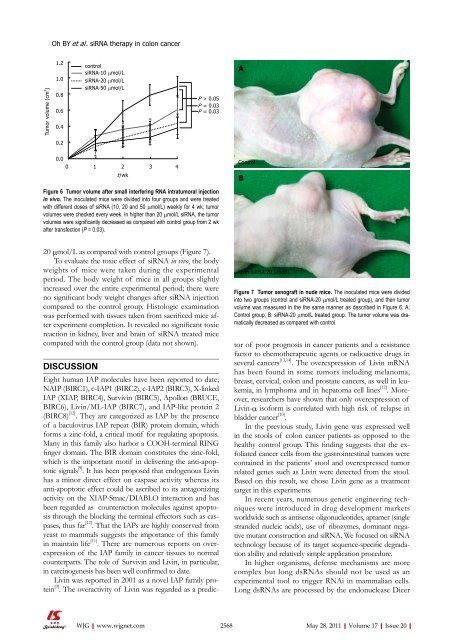20 - World Journal of Gastroenterology
20 - World Journal of Gastroenterology
20 - World Journal of Gastroenterology
You also want an ePaper? Increase the reach of your titles
YUMPU automatically turns print PDFs into web optimized ePapers that Google loves.
Tumor volume (cm 3 )<br />
Oh BY et al . siRNA therapy in colon cancer<br />
1.2<br />
1.0<br />
0.8<br />
0.6<br />
0.4<br />
0.2<br />
0.0<br />
0 1 2 3 4<br />
t /wk<br />
<strong>20</strong> μmol/L as compared with control groups (Figure 7).<br />
To evaluate the toxic effect <strong>of</strong> siRNA in vivo, the body<br />
weights <strong>of</strong> mice were taken during the experimental<br />
period. The body weight <strong>of</strong> mice in all groups slightly<br />
increased over the entire experimental period; there were<br />
no significant body weight changes after siRNA injection<br />
compared to the control group. Histologic examination<br />
was performed with tissues taken from sacrificed mice after<br />
experiment completion. It revealed no significant toxic<br />
reaction in kidney, liver and brain <strong>of</strong> siRNA treated mice<br />
compared with the control group (data not shown).<br />
DISCUSSION<br />
control<br />
siRNA-10 μmol/L<br />
siRNA-<strong>20</strong> μmol/L<br />
siRNA-50 μmol/L<br />
Figure 6 Tumor volume after small interfering RNA intratumoral injection<br />
in vivo. The inoculated mice were divided into four groups and were treated<br />
with different doses <strong>of</strong> siRNA (10, <strong>20</strong> and 50 μmol/L) weekly for 4 wk; tumor<br />
volumes were checked every week. In higher than <strong>20</strong> μmol/L siRNA, the tumor<br />
volumes were significantly decreased as compared with control group from 2 wk<br />
after transfection (P = 0.03).<br />
Eight human IAP molecules have been reported to date;<br />
NAIP (BIRC1), c-IAP1 (BIRC2), c-IAP2 (BIRC3), X-linked<br />
IAP (XIAP, BIRC4), Survivin (BIRC5), Apollon (BRUCE,<br />
BIRC6), Livin/ML-IAP (BIRC7), and IAP-like protein 2<br />
(BIRC8) [12] . They are categorized as IAP by the presence<br />
<strong>of</strong> a baculovirus IAP repeat (BIR) protein domain, which<br />
forms a zinc-fold, a critical motif for regulating apoptosis.<br />
Many in this family also harbor a COOH-terminal RING<br />
finger domain. The BIR domain constitutes the zinc-fold,<br />
which is the important motif in delivering the anti-apoptotic<br />
signals [9] . It has been proposed that endogenous Livin<br />
has a minor direct effect on caspase activity whereas its<br />
anti-apoptotic effect could be ascribed to its antagonizing<br />
activity on the XIAP-Smac/DIABLO interaction and has<br />
been regarded as counteraction molecules against apoptosis<br />
through the blocking the terminal effectors such as caspases,<br />
thus far [12] . That the IAPs are highly conserved from<br />
yeast to mammals suggests the importance <strong>of</strong> this family<br />
in maintain life [11] . There are numerous reports on overexpression<br />
<strong>of</strong> the IAP family in cancer tissues to normal<br />
counterparts. The role <strong>of</strong> Survivin and Livin, in particular,<br />
in carcinogenesis has been well confirmed to date.<br />
Livin was reported in <strong>20</strong>01 as a novel IAP family protein<br />
[9] . The overactivity <strong>of</strong> Livin was regarded as a predic-<br />
WJG|www.wjgnet.com<br />
P > 0.05<br />
P = 0.03<br />
P = 0.03<br />
A<br />
Control<br />
B<br />
Livin-siRNA <strong>20</strong> μmol/L<br />
Figure 7 Tumor xenograft in nude mice. The inoculated mice were divided<br />
into two groups (control and siRNA-<strong>20</strong> μmol/L treated group), and then tumor<br />
volume was measured in the the same manner as described in Figure 6. A:<br />
Control group; B: siRNA-<strong>20</strong> μmol/L treated group. The tumor volume was dramatically<br />
decreased as compared with control.<br />
tor <strong>of</strong> poor prognosis in cancer patients and a resistance<br />
factor to chemotherapeutic agents or radioactive drugs in<br />
several cancers [13,14] . The overexpression <strong>of</strong> Livin mRNA<br />
has been found in some tumors including melanoma,<br />
breast, cervical, colon and prostate cancers, as well in leukemia,<br />
in lymphoma and in hepatoma cell lines [12] . Moreover,<br />
researchers have shown that only overexpression <strong>of</strong><br />
Livin-α is<strong>of</strong>orm is correlated with high risk <strong>of</strong> relapse in<br />
bladder cancer [10] .<br />
In the previous study, Livin gene was expressed well<br />
in the stools <strong>of</strong> colon cancer patients as opposed to the<br />
healthy control group. This finding suggests that the exfoliated<br />
cancer cells from the gastrointestinal tumors were<br />
contained in the patients’ stool and overexpressed tumor<br />
related genes such as Livin were detected from the stool.<br />
Based on this result, we chose Livin gene as a treatment<br />
target in this experiments.<br />
In recent years, numerous genetic engineering techniques<br />
were introduced in drug development markets<br />
worldwide such as antisense oligonucleotides, aptamer (single<br />
stranded nucleic acids), use <strong>of</strong> ribozymes, dominant negative<br />
mutant construction and siRNA. We focused on siRNA<br />
technology because <strong>of</strong> its target sequence-specific degradation<br />
ability and relatively simple application procedure.<br />
In higher organisms, defense mechanisms are more<br />
complex but long dsRNAs should not be used as an<br />
experimental tool to trigger RNAi in mammalian cells.<br />
Long dsRNAs are processed by the endonuclease Dicer<br />
2568 May 28, <strong>20</strong>11|Volume 17|Issue <strong>20</strong>|

















